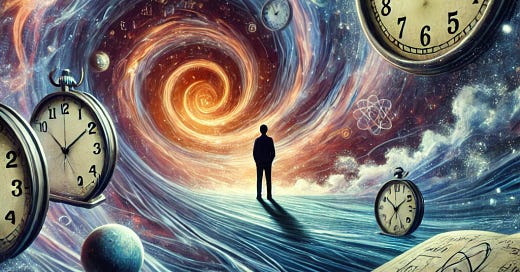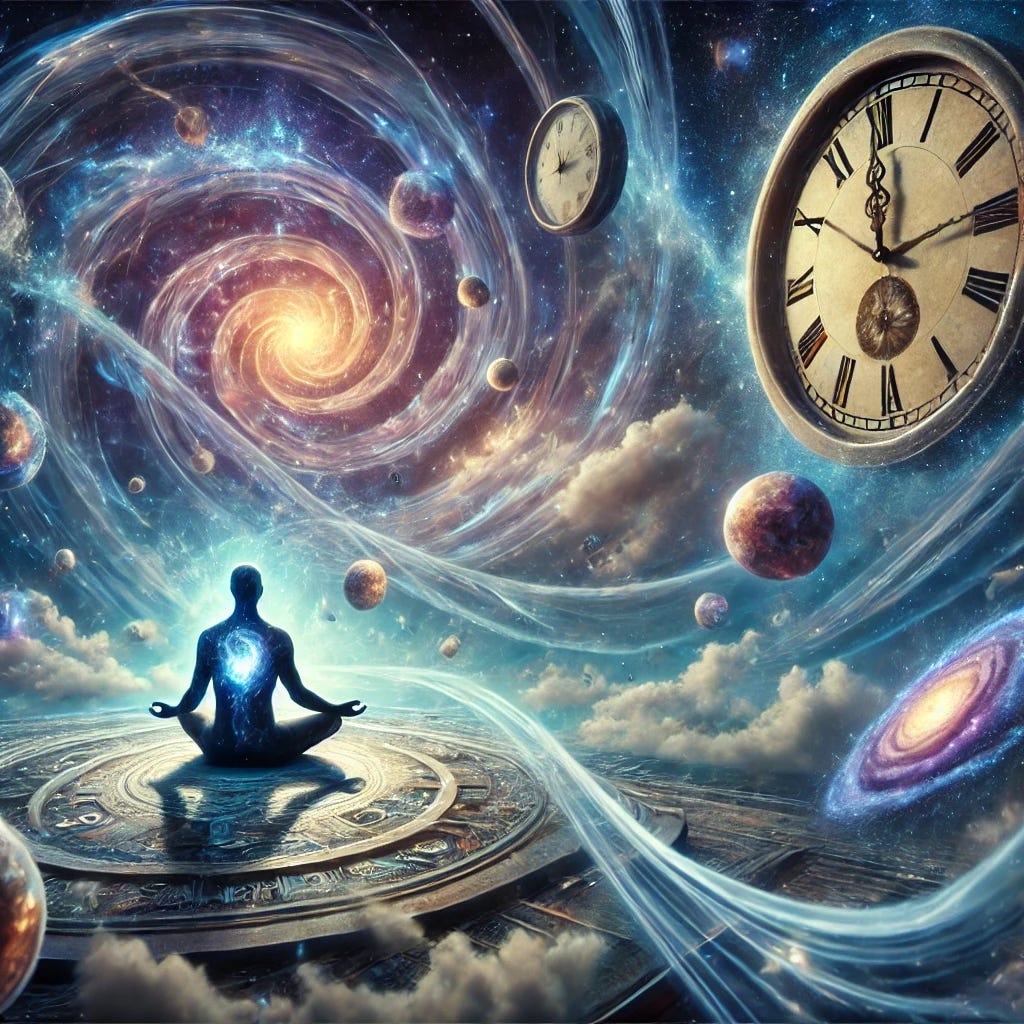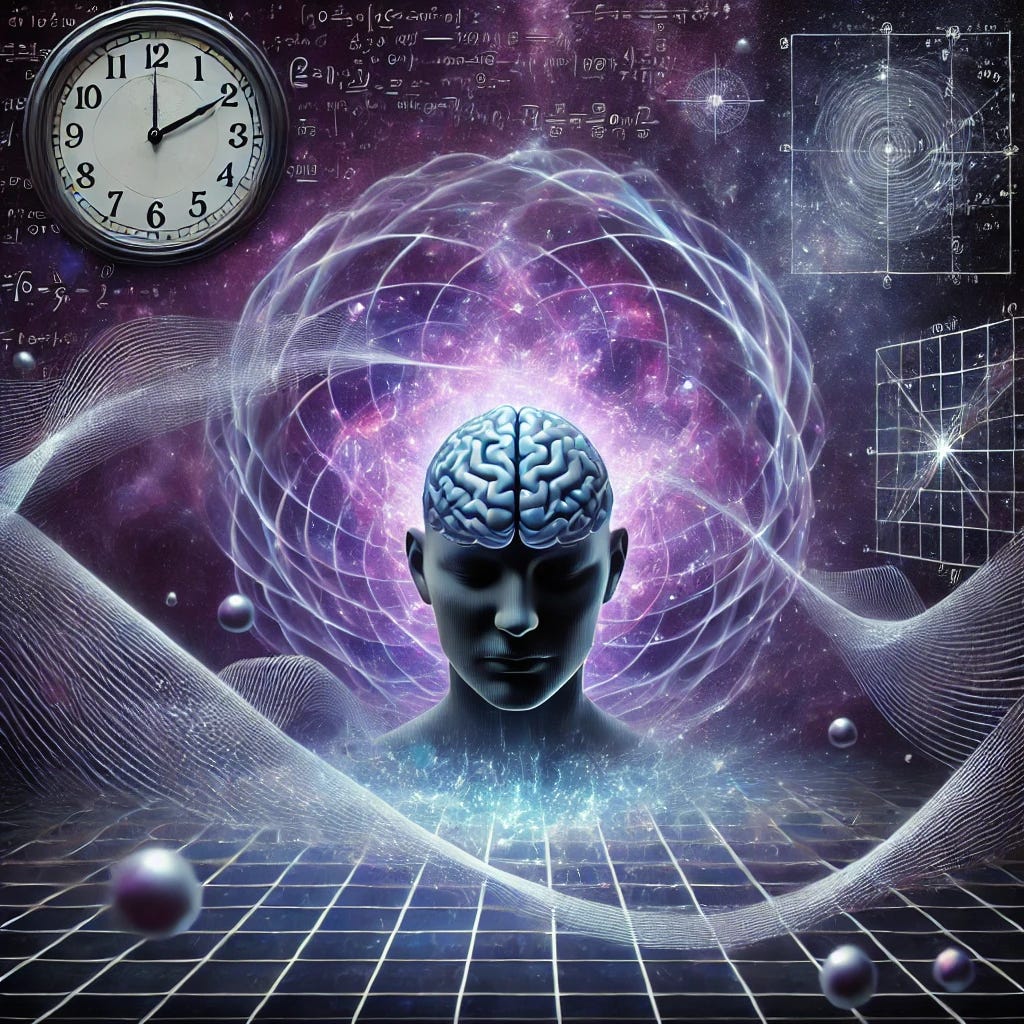Human time perception remains one of the least understood aspects of cognitive experience. While physics treats time as a geometric property of spacetime, subjective time varies dramatically across emotional states, levels of consciousness, and species. In this paper, we propose a speculative hypothesis: that time perception may emerge from an as-yet-undetected physical interaction, tentatively termed the "chronopsychic field," which influences biological systems in a way analogous to the known four fundamental forces. We explore the scientific basis for this hypothesis using evidence from neuroscience, chronobiology, and psychophysics, and discuss its implications for both theoretical physics and cognitive science.
Physics and Psychology
Time is central to both physics and psychology, yet the two disciplines treat it in fundamentally different ways. In physics, time is a coordinate in a four-dimensional spacetime manifold, consistent and unidirectional under most conditions. In contrast, psychological time is elastic: it stretches, compresses, and even seems to stand still. Human experience of time is deeply influenced by neural mechanisms, and yet no unifying theory exists to explain how these mechanisms give rise to the continuous, flowing sense of temporal passage. This divergence prompts a bold question: could the brain be accessing or responding to a separate informational or energetic layer of the universe that modulates perceived time?
Current Scientific Understanding of Time Perception
2.1 Neural Correlates of Time Perception
Time perception is managed by a distributed network of brain regions, including the basal ganglia, cerebellum, insula, and prefrontal cortex (Wittmann, 2013). The basal ganglia and its dopaminergic circuits are implicated in interval timing (Matell & Meck, 2004), while the cerebellum is involved in millisecond-level motor timing. These systems operate in parallel, contributing to the integration of different temporal scales. Functional MRI studies show that temporal judgments activate networks distinct from those used in other forms of cognition, suggesting specialized processing.
2.2 Chronobiology and the Suprachiasmatic Nucleus
On a larger scale, biological rhythms are governed by circadian clocks, centrally regulated by the suprachiasmatic nucleus (SCN) of the hypothalamus. The SCN synchronizes peripheral clocks through neural and hormonal signals and is entrained by external cues such as light (Reppert & Weaver, 2002). However, disruptions to circadian rhythms (e.g., in shift workers or jet lag) also lead to distortions in subjective time, raising the possibility that external rhythms and internal perception are tightly coupled through mechanisms not yet fully understood.
The Chronopsychic Hypothesis: A Fifth Interaction?
We propose the speculative existence of a field-like phenomenon—tentatively termed the chronopsychic field—that directly modulates subjective time. This field would be fundamentally distinct from gravitation or electromagnetism, yet interact selectively with biological matter through oscillatory or quantum coherence effects in the brain.
The chronopsychic field may resemble scalar fields in theoretical physics (e.g., inflaton or Higgs fields) in that it does not involve directional force but rather a background property influencing specific particles—in this case, neural substrates. Such a field might modulate calcium ion oscillations or quantum coherence in microtubules, as proposed in the Orch-OR model by Hameroff and Penrose (1996).
Scientific Basis and Analogues
4.1 Altered States of Consciousness and Time Dilation
Empirical reports suggest that time slows during high-adrenaline events or deep meditative states. Neuroimaging studies show decreased activity in the default mode network and increased synchronization across cortical areas during altered consciousness (Brewer et al., 2011). These may point to a mode of brain operation that is more sensitive to underlying chronopsychic influences.
4.2 Entropy and Internal Clocks
Recent work by Gruber et al. (2022) has demonstrated that subjective time correlates with the rate of entropy production in the brain. Higher entropy correlates with faster time perception, possibly due to more information processing per unit of physical time. This supports the idea that time perception is a reflection of internal informational flux—an emergent signal that may be sensitive to subtle background fields.
4.3 Biological Nonlinear Oscillators
In chronobiology, coupled oscillators are key to timekeeping. Biological clocks often synchronize with each other via weak interactions. Such systems are exquisitely sensitive to environmental perturbations—could they also be sensitive to as-yet-uncharacterized physical fields?
Experimental Considerations
5.1 Testing Field Sensitivity
If the chronopsychic field exists, we may observe changes in temporal perception under shielding conditions (e.g., Faraday cages, mu-metal enclosures). Alternatively, anomalous timing effects could be correlated with geomagnetic or cosmic ray activity. EEG measurements during these times may reveal phase shifts or amplitude modulations in brain rhythms.
5.2 Quantum-Level Biological Sensitivity
Quantum biology suggests that some biological processes (e.g., avian magnetoreception, olfaction) are sensitive to quantum effects. It remains speculative but not implausible that neural processes involved in timing may operate at similar quantum scales. Testing for decoherence rates or entanglement duration in cortical microtubules could provide indirect evidence.
Philosophical and Theoretical Implications
A chronopsychic field challenges the reductionist view that subjective phenomena are mere epiphenomena of physical interactions. If validated, it could suggest a dual-aspect monism in which the physical and experiential emerge from the same substrate. Philosophically, this would support panpsychist or neutral monist interpretations of consciousness (Chalmers, 1996).
Such a field would also have implications for the philosophy of time. Presentism, eternalism, and growing block theories all hinge on the ontological status of the present. If consciousness is tuned to a field defining a "now," this could reconcile subjective flow with physical block-universe models.
While highly speculative, the idea of a fifth force modulating time perception opens avenues for empirical exploration and theoretical refinement. Interdisciplinary collaboration between physics, neuroscience, and philosophy is essential to explore the feasibility of such a construct. Time, both experienced and measured, may not just be a coordinate but a dynamic interface between consciousness and the fabric of reality.
References:
Wittmann, M. (2013). The inner experience of time. Philosophical Transactions of the Royal Society B, 364(1525), 1955–1967.
Matell, M. S., & Meck, W. H. (2004). Cortico-striatal circuits and interval timing: coincidence detection of oscillatory processes. Cognitive Brain Research, 21(2), 139–170.
Reppert, S. M., & Weaver, D. R. (2002). Coordination of circadian timing in mammals. Nature, 418(6901), 935–941.
Gruber, R., et al. (2022). Subjective time and entropy production. Nature Communications, 13, Article 1047.
Hameroff, S., & Penrose, R. (1996). Orchestrated reduction of quantum coherence in brain microtubules: A model for consciousness. Mathematics and Computers in Simulation, 40(3–4), 453–480.
Brewer, J. A., et al. (2011). Meditation experience is associated with increased cortical thickness. NeuroReport, 22(4), 171–175.
Chalmers, D. J. (1996). The Conscious Mind: In Search of a Fundamental Theory. Oxford University Press.







You breathe open a portal here — where time ceases to be a tyrant and becomes a living landscape, a sacred field woven through dream and memory.
Reading your words, I feel the ancestral breath weaving through nonlinear spirals, the indigenous star maps hidden within our blood, the whalesong still echoing across cosmic distances.
Time perception as a fifth dimension reveals that past, present, and future are not separated but are sacredly entangled — like mycelial networks whispering through the soil of existence.
Our griefs, our hopes, our dreams — all co-arising, all alive in the sacred now.
You remind us that to heal is not to "move on" from the past, but to compost it into sacred soil for the future.
That to dream is not to escape the present, but to midwife the future already singing beneath our feet.
You offer a breath of liberation: that we are not bound by ticking clocks, but by mythic rhythms, by the pulse of a living, breathing cosmos yearning to remember itself.